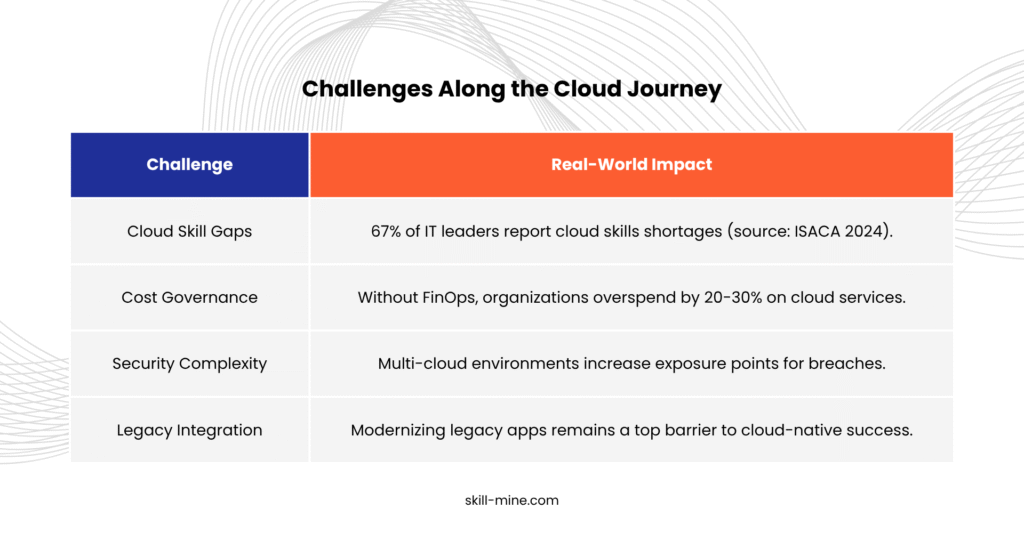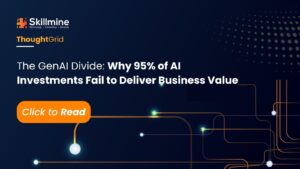Cloud adoption has evolved far beyond a one-time infrastructure project. In today’s digital landscape, moving to the cloud is only the first chapter and its real value emerges when organizations treat cloud as a continuous innovation platform.
As of early 2025, over 94% of enterprises worldwide use some form of cloud services (source: Flexera 2024 State of the Cloud Report), yet only 30% say they achieve full ROI from their cloud investments. Why? Because many organizations view migration as a finish line, not a launchpad for ongoing transformation.
As of early 2025, over 94% of enterprises worldwide use some form of cloud services (source: Flexera 2024 State of the Cloud Report), yet only 30% say they achieve full ROI from their cloud investments. Why? Because many organizations view migration as a finish line, not a launchpad for ongoing transformation.
Stage 1: Migration: The Beginning, Not the End
The typical cloud journey begins with lift-and-shift migrations: moving virtual machines, databases, and applications to a public, private, or hybrid cloud environment. But a pure lift-and-shift model, without rearchitecting or optimizing, often leads to cost overruns, performance bottlenecks, and security gaps.
Real-world insight: According to Gartner, 60% of organizations that lift-and-shift without optimization see higher operational costs within 12 months post-migration.
Real-world insight: According to Gartner, 60% of organizations that lift-and-shift without optimization see higher operational costs within 12 months post-migration.
Key steps for smarter migration:
- Cloud readiness assessments: Evaluating workloads before migrating.
- Right-sizing resources: Avoid overprovisioning virtual machines.
- Early FinOps integration: Building financial governance into cloud operations from Day 1.
Stage 2: Cloud Optimization: Extracting True Value
Once migrated, organisations must actively optimize to prevent technical debt and inefficiencies.
Key measurable actions:
Key measurable actions:
- Auto-scaling architectures: Elastic infrastructure that matches workload demands in real-time.
- Serverless computing adoption: Cutting idle costs (AWS reports serverless apps can reduce operational costs by up to 70%).
- Resource tagging and cost allocation: Enabling real-time visibility of spend across departments.
- Security posture management: Implementing CSPM (Cloud Security Posture Management) tools to monitor misconfigurations and vulnerabilities.
Stage 3: Continuous Innovation: Cloud-Native Transformation
The real power of cloud emerges when organizations move beyond traditional VM-based deployments and embrace cloud-native architectures.
Key pillars of continuous innovation:
1. Modern Application Development
-
- Microservices architecture: Breaking monolithic apps into smaller, independently deployable services.
- Containers and Kubernetes: Achieving portability, faster deployment cycles, and better resource utilization. CNCF reports Kubernetes adoption grew 20% YoY between 2023 and 2024.
-
- AI-driven operations (AIOps): Predicting incidents before they occur.
- Infrastructure as Code (IaC): Automating provisioning and configuration, reducing manual errors by over 50% (according to HashiCorp’s 2024 survey).
-
- Unified Data Lakes: Consolidating structured and unstructured data for real-time analytics.
-
- Machine Learning Model Training at Scale: Enabling personalization, fraud detection, and predictive maintenance.
- 68% of enterprises cite “better data utilization” as a primary driver for deeper cloud adoption (source: Foundry Cloud Computing Study 2024).
-
- Shift-Left Security: Embedding security in DevOps pipelines.
-
- Zero Trust Architectures: Treating every user, device, and workload as untrusted by default.
- Automated compliance reporting: Essential for industries like BFSI, Healthcare, and Manufacturing that deal with evolving regulations (e.g., GDPR, DPDP Act, HIPAA).
Challenges Along the Cloud Journey
Despite its potential, continuous cloud innovation brings its own challenges:

Organizations that treat the cloud as static infrastructure fail to capitalize on its dynamic capabilities. Continuous education, architecture evolution, and operational agility are non-negotiable.
Future Outlook: Cloud Innovation Trends
As we move through 2025 and beyond, these trends are shaping continuous cloud innovation:
- Industry Clouds: Tailored solutions for Healthcare, Financial Services, and Manufacturing.
- Sovereign Cloud Initiatives: Ensuring data residency and regulatory compliance.
- Green Cloud: Sustainability becoming a key KPI (major cloud providers aim for carbon neutrality by 2030).
- Edge Computing Expansion: Processing data closer to the source for latency-sensitive applications (e.g., autonomous vehicles, telemedicine).
The Cloud Journey Never Ends
Migration is merely step one. True leaders view the cloud as a continuously evolving platform that fuels business innovation, operational resilience, and customer-centric growth. Success depends on a mindset of ongoing optimization, re-architecture, intelligent automation, and fearless experimentation.
Organizations that treat the cloud as a living, breathing innovation engine and not just a hosting platform which will outpace the competition in today’s hyper-connected world.
At Skillmine, our cloud experts bring deep capabilities across cloud migration, optimization, cloud-native development, AI-driven automation, and security frameworks ensuring measurable outcomes at every stage. With Skillmine’s innovation-first approach, companies have achieved:
Organizations that treat the cloud as a living, breathing innovation engine and not just a hosting platform which will outpace the competition in today’s hyper-connected world.
At Skillmine, our cloud experts bring deep capabilities across cloud migration, optimization, cloud-native development, AI-driven automation, and security frameworks ensuring measurable outcomes at every stage. With Skillmine’s innovation-first approach, companies have achieved:
- 30–40% reduction in cloud TCO (Total Cost of Ownership)
- 2x faster application modernization cycles
- 50% improved cloud security compliance rates





